“We have had ten important casualties. Ten!” Shakhtar Donetsk coach, Luis Castro didn’t hold back in his interview with MARCA, pointing the incredible level of adaptation the COVID-19 crisis had brought upon his club.
Though a few key players managed to lace up their boots, the side featured eight players who are 23 or younger, and that’s just the starting XI. All three subs ranged from 18 to 20 years old.
Despite the extraordinary number of absences and the strength of Real Madrid, even despite the absences of Sergio Ramos, Eden Hazard and Martin Ødegaard, Shakhtar Donetsk managed one of the greatest upsets in club history.
This tactical analysis breaks down the approach Castro’s side took while claiming the three important points. We’ll look at each side’s defensive structures, how Shakhtar’s build-up picked apart the Madrid press and finish with an analysis of Zinedine Zidane’s second half adjustments.
Lineups
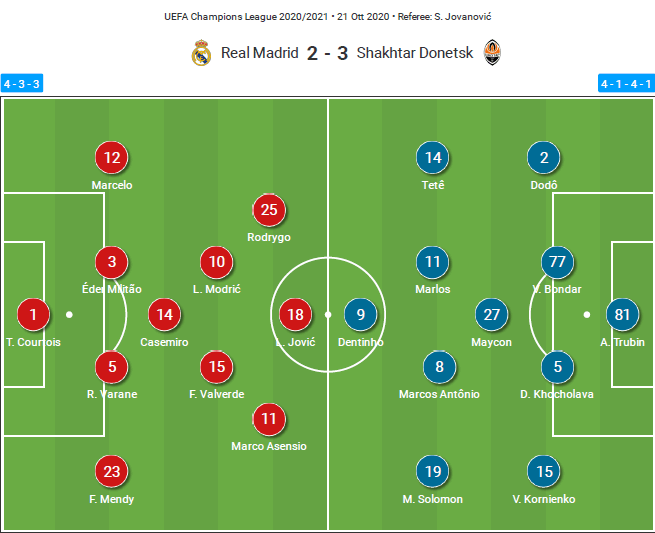
Zidane started the game with a heavily rotated side, leaving just Thibaut Courtois, Raphaël Varane, Marcelo and Luka Modrić in the starting lineup from the weekend upset against Cádiz. Éder Militão and Ferland Mendy stepped into the starting lineup, as did Casemiro and Federico Valverde in midfield. The top line of the 4-3-3 consisted of Rodrygo Goes on the left, Marco Asensio on the right and embattled Luka Jović centrally.
On the other touchline, the Portuguese Castro went with a 4-1-4-1, calling upon the 19-year-old Ukrainian international, Anatoliy Trubin, to replace Andriy Pyatov in goal. The backline consisted of Dodô, Valeriy Bondar, Davit Khocholava and Viktor Korniyenko. In midfield, the Brazilian youth international, Maycon, was the lone pivot. Fellow Brazilian youth international Marcos Antônio and the highly-experienced Marlos played in front of Maycon. That left the young Israeli sensation, Manor Solomon, on the left, Brazil U20’s Tetê and the long-time Shakhtar striker, Dentinho, as the lone striker.
Real Madrid’s poorly executed high press
The match got off to a tepid start, in large part due to the pressing tactics of the two teams. Over the first 15 minutes of the match, Real Madrid played of off Shakhtar, owning a 49.5 PPDA (passes per defensive action) compared to the Ukrainian side’s 29 PPDA. The La Liga champions averaged a 19.5 PPDA in the first half, so they weren’t in a hurry to win the ball back quickly.
That said, the man-marking high press was still in effect, though certainly not effective. A listless first half saw Zidane’s side control the ball for just 47% of the first 45. Even though Shakhtar had the ball for the better part of the first half, it’s interesting to note that their average formation line, which measures the team’s average location on all team events with the ball, saw the Ukrainians an average of 44.5 yards from their own goal. For reference, Real Madrid’s second half average formation line was 61.8 yards from their own goal, putting them in the Shakhtar half of the pitch.
With Castro’s men having a deep starting point and 53% of possession, building out of the back was a core tenant to their approach. In a sense, Real Madrid took the bait, pressing high up the pitch. Los Blancos pushed higher and higher in response to Shakhtar dropping their midfield to support the build-up. Once Madrid overcommitted, Castro’s side was quick to move into the space between the lines.
Since the high man-marking press was largely ineffective, Varane and Militão frequently moved into midfield to defend against the outlet pass. Dentinho and the centre midfielders were highly effective in drawing the Madrid centre-backs higher up the pitch.
The sequence below gives a nice visual. As Shakhtar built out of the back, Real Madrid looked to pin them on one of the wings. However, the Spanish side was largely unable to take away the deep outlet or restrict his passing options, as is seen below. Notice Maycon sitting in the gap.
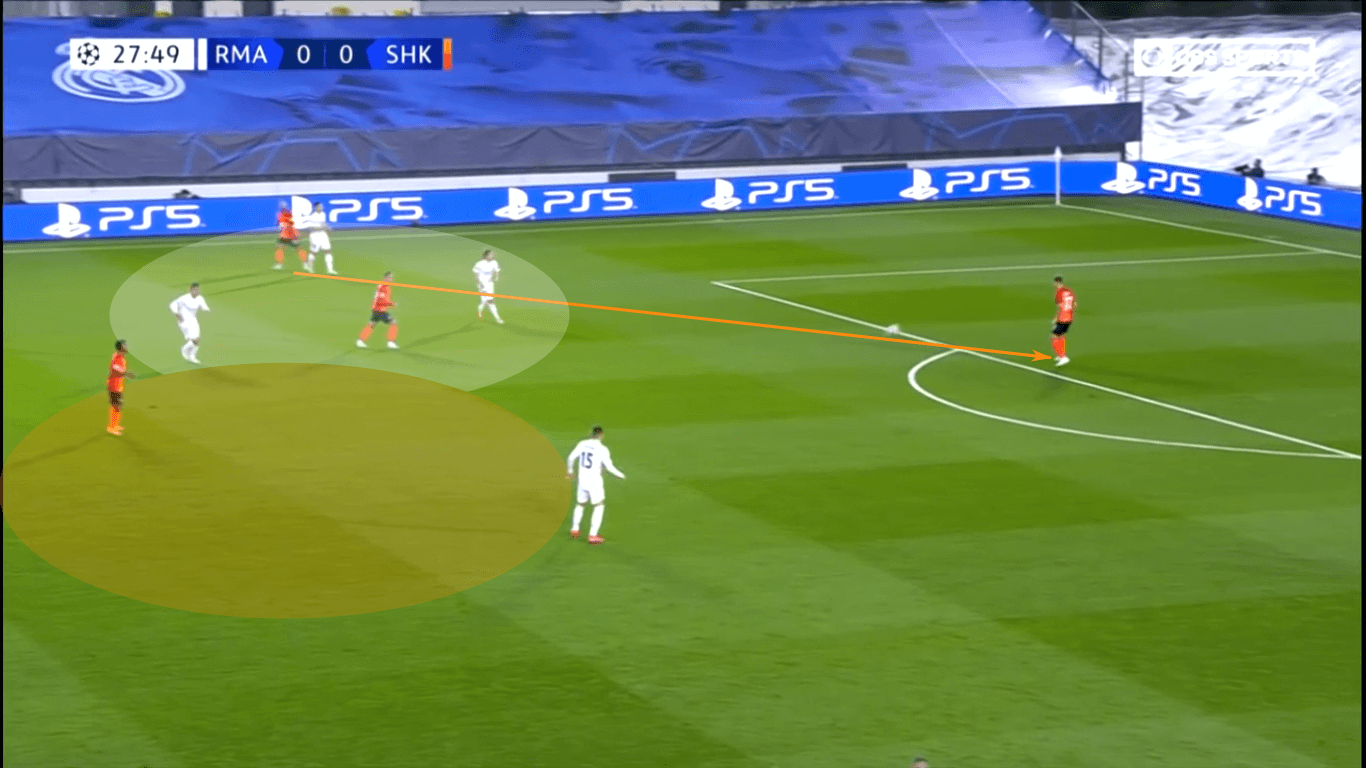
Looking at Marcos Antônio’s nearest defender, you see Casemiro far up the pitch engaging in the high press. That left a huge gap between the midfield and defensive lines, especially in the middle of the pitch. Shakhtar knew they were ready to progress once the Madrid press was divided, preferably with the front five or six unbalanced to one wing and the centre-backs taking the bait to move into the midfield.
Once Shakhtar accomplished those build-up objectives, they attacked the Madrid defence with remarkable pace. In this instance, Bondar split the defence, finding the feet of Solomon. The Israeli international played square to Marcos Antônio, allowing the #8 to engage the defence from a better angle.
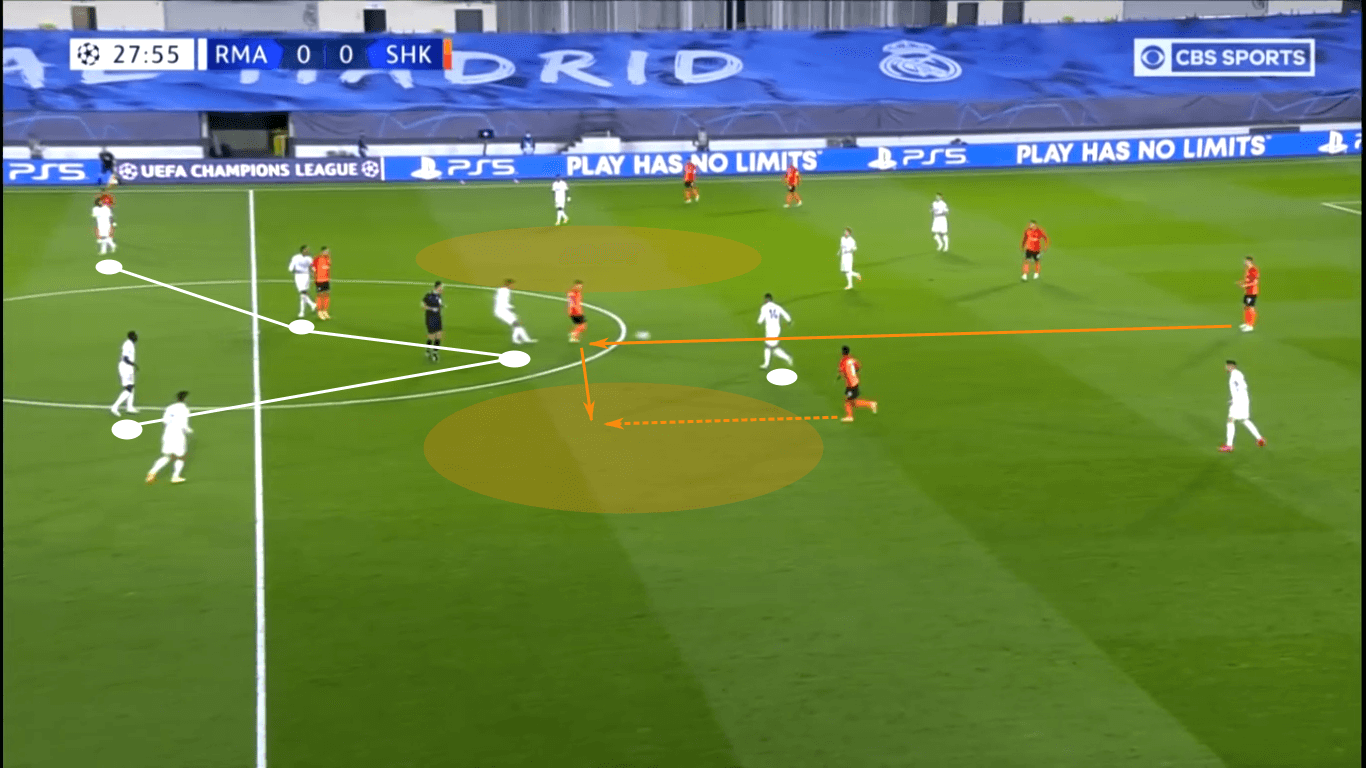
The most significant aspect of this sequence is how high up the pitch the two Madrid centre-backs pushed. Varane and Militão are well ahead of the two outside-backs, leaving a large gap in the central channel.
Marcos Antônio played the ball into the path of Dentinho, who managed to slip the ball wide to Kornienko.
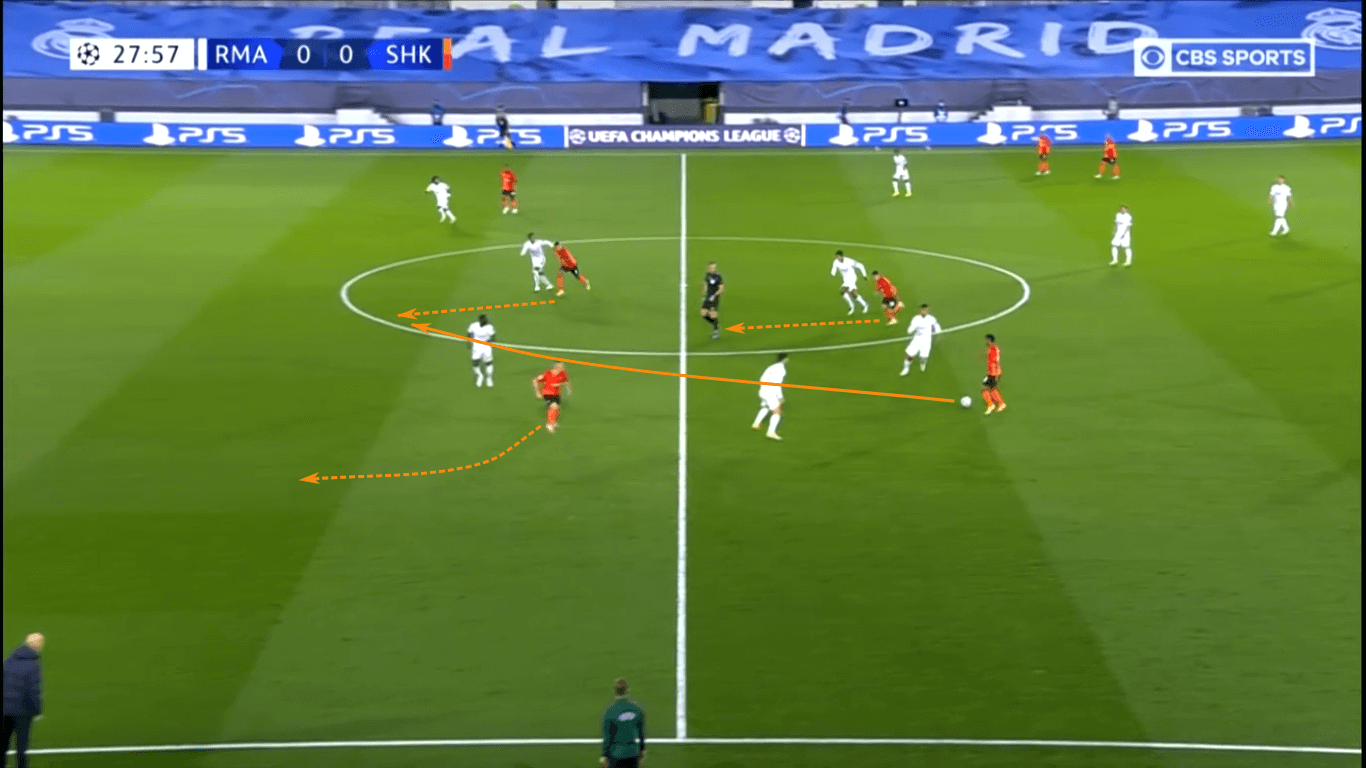
Because of Solomon’s run, Militão and Varane switch on the play, leaving the Brazilian awkwardly situated to deal with Kornienko’s dribble. In the image below, we find Varane patrolling the half space, but he’s taken a zonal approach, leaving him too far to provide necessary coverage.
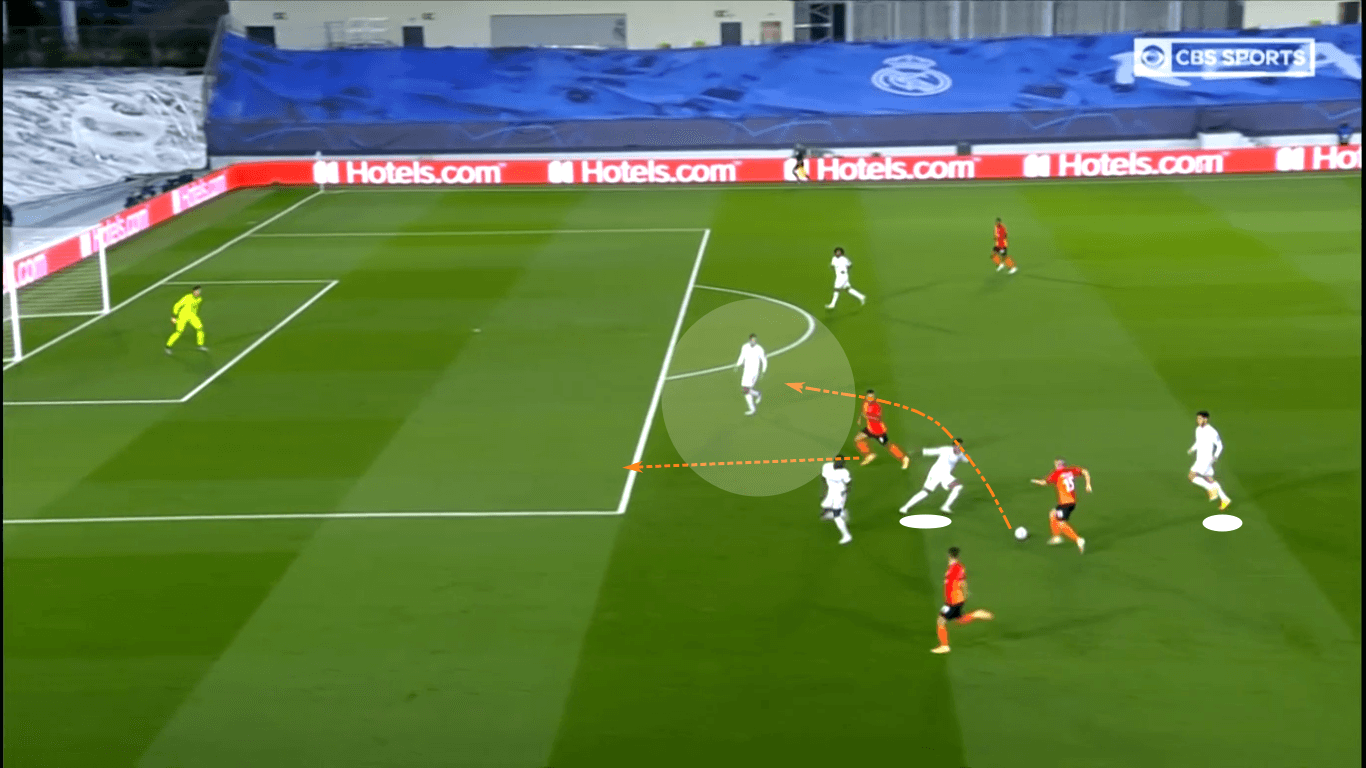
As Kornienko cut inside, he managed to outmuscle Varane and poke the ball past Marcelo at the last possible moment. As the ball arrived at Tetê’s left foot, the young Brazilian squared his hips and guided a bending shot past the outstretched arms of Courtois.
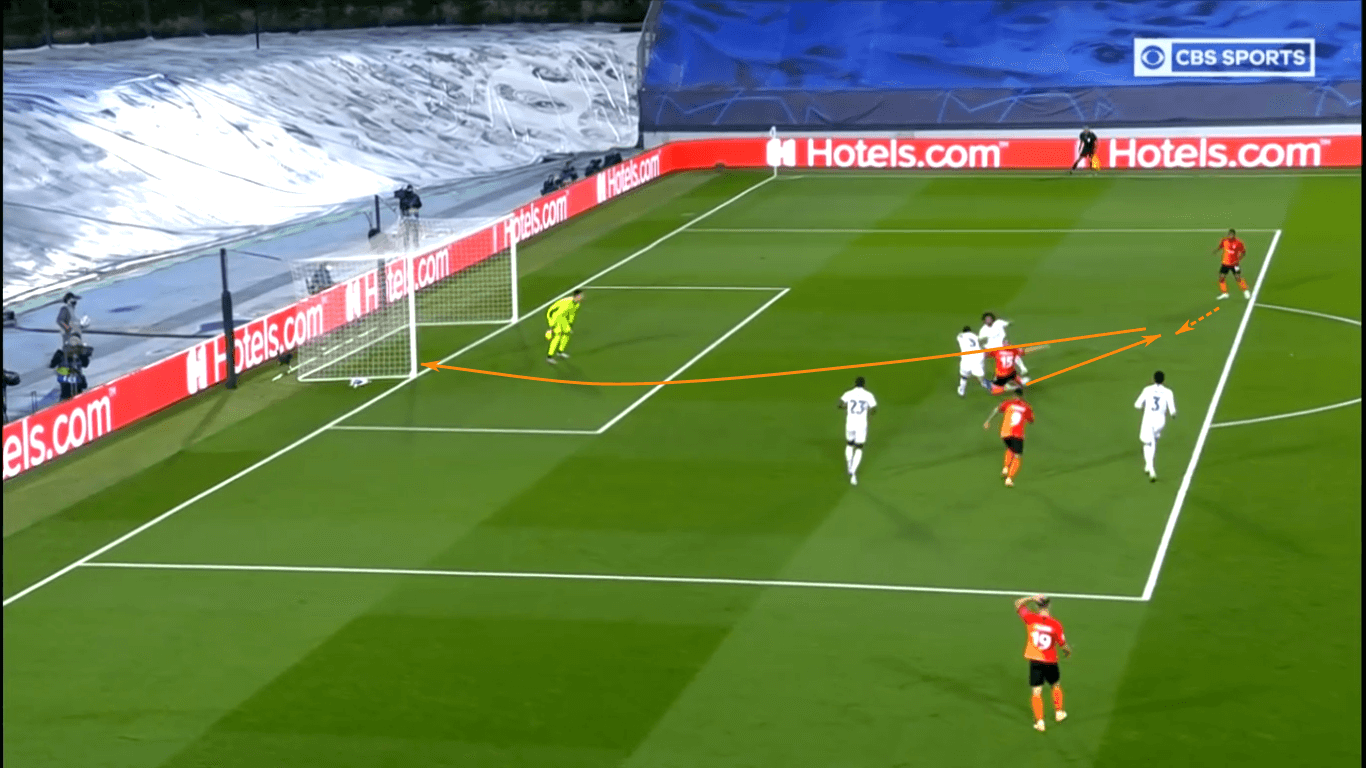
Engaging in a man-marking high press worked for Real Madrid last season, but that press was extremely disciplined, removing all short and intermediate outlets. With the front five so ineffective in the high press, Casemiro pushed higher, but the result was gaps for Shakhtar to attack. Though the starting XI were not his preferred bunch, Zidane will surely be troubled by their inability to care out the defensive tactics or apply adequate pressure on the opposition’s build-up, especially since Shakhtar was missing nearly a full starting XI.
Shakhtar’s midfield line of confrontation slows Madrid’s attack
Shakhtar tended to play closer to their goal, so the defensive tactics were fairly straightforward. The standard shape was a 4-1-4-1 with Maycon patrolling the space between the lines. Those lines were very compact, leaving him with little guesswork. Credit is due to this young Shakhtar side, many of whom are not regular starters, for the disciplined approach in this game.
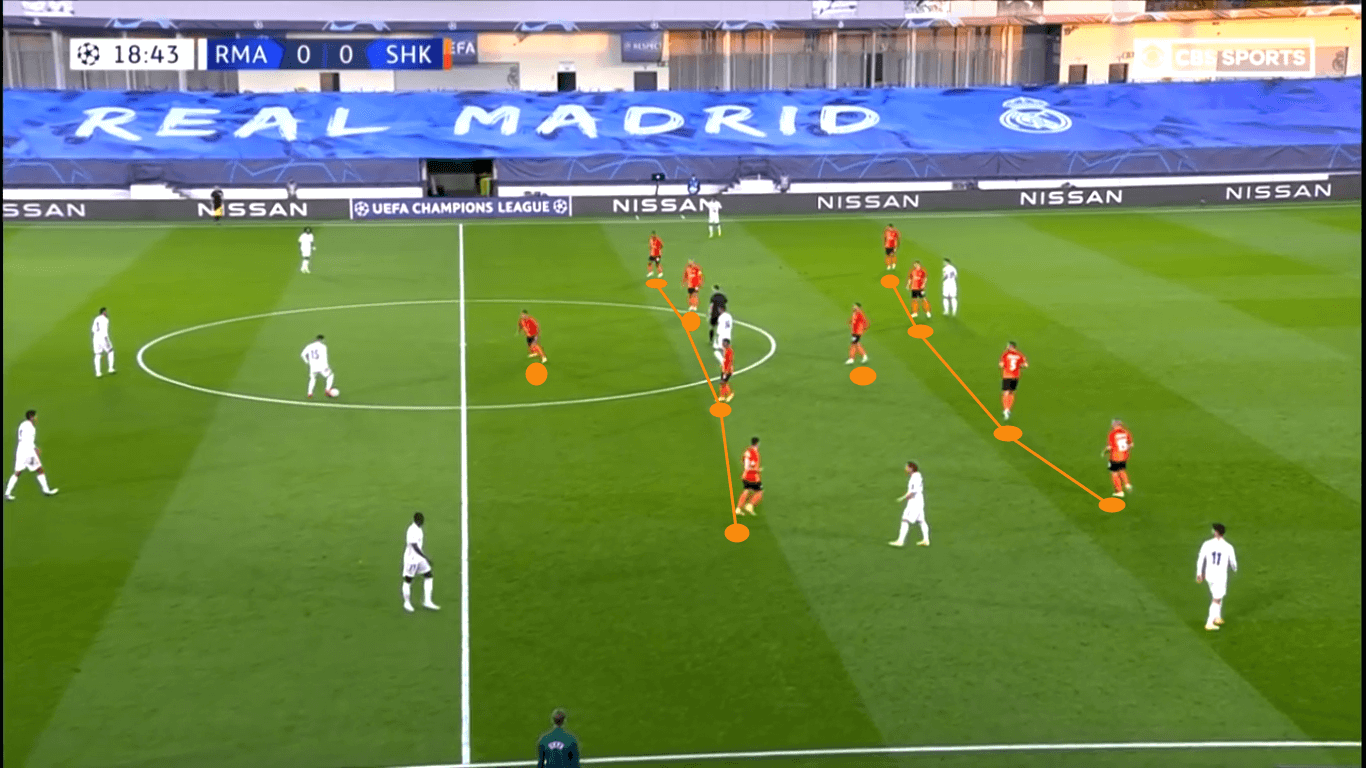
In the first half, Shakhtar had a 20.3 PPDA. Usually a lightening fast counterpressing side, the clear emphasis was denying space centrally and limiting space both between the lines and behind the backline. In fact, they didn’t record a single recovery in the attacking third of the pitch and only eight in the middle third. The final 62 recoveries came in the defensive third, showing the clear approach outlined by the staff.
An interesting tactical feature is that when Real Madrid would play a negative pass, Castro’s side often merged from the 4-1-4-1 to a 4-3-2-1. The two wide midfielders covered the widest parts of the formation, giving the press the appearance of an arrowhead.
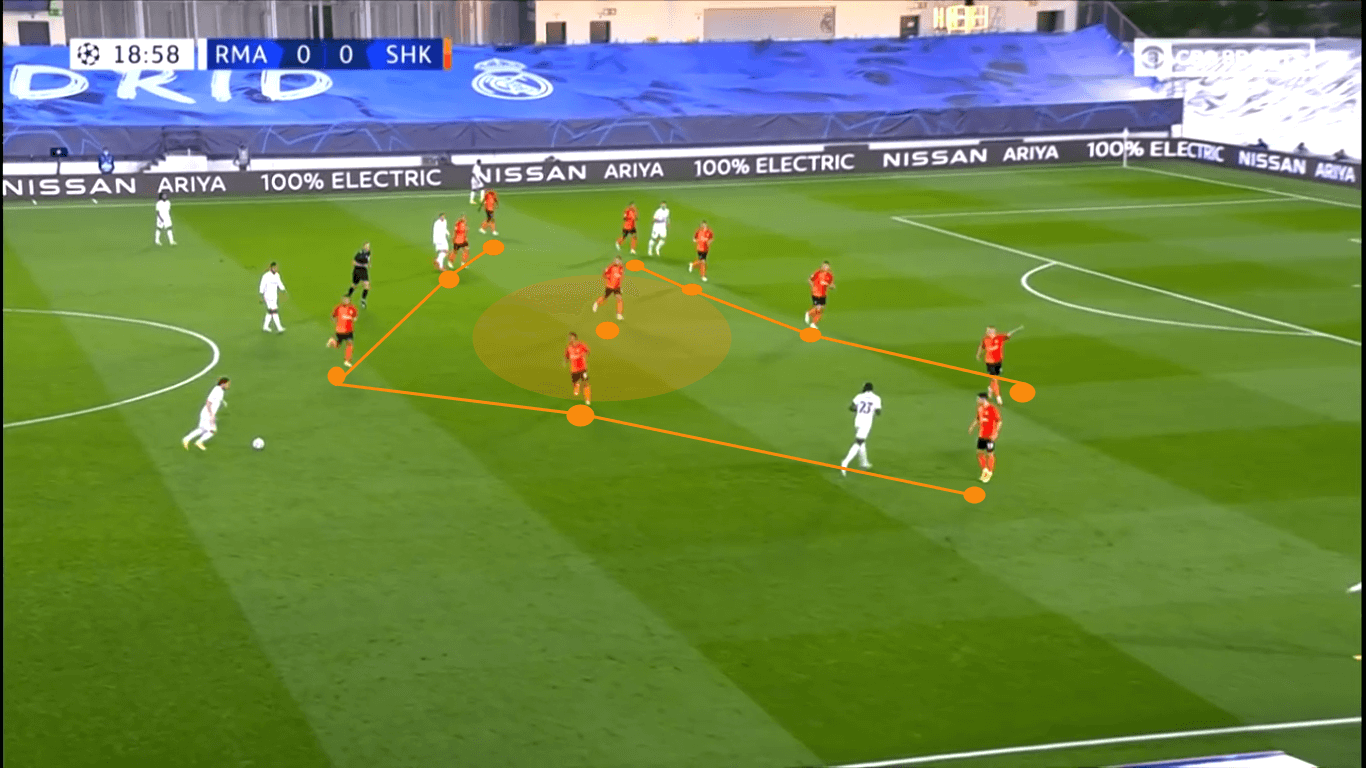
Maycon was the lone player in the central circle. He was tasked with picking out any passes sent into the central channel. Real Madrid had no joy in the middle, so the young #6 will be pleased with his performance.
Shakhtar’s direct attacking
Since the first section of this analysis covered the Real Madrid high press, you’ve already caught a glimpse of Shakhtar’s build-out. However, their building out of the back was such an important attacking tactic, really the core principle of their approach, that it deserves its own section.
Despite 53% possession in the first half, 43% for the game, one of the most fascinating stats of the match is that just 32% of Shakhtar’s possession’s reached the attacking half. That’s right, 30 of 94 possessions saw the visitors reach Real Madrid territory. 36 of their 72 possessions (50%) were classified as “short” (0-10 seconds), but that’s mainly down to Real Madrid’s second half counterpress and the massive Shakhtar lead.
However, when Shakhtar managed to beat the high press, they were lethal. For the match, the visitors enjoyed a 40% to 12% advantage in attacks ending with a shot on goal. While quantity was massively skewed in Madrid’s favour, they only finished with two more shots from positional attacks than Shakhtar.
As Shakhtar built out of the back in the first half, the visual cue they were looking for was to disconnect the forwards and midfielders from the backline. If they could draw Casemiro, Modrić and Valverde higher up the pitch, they would then target the space in front of the backline. Since Real Madrid’s high press lacked adequate pressure on the ball carrier and allowed Shakhtar to relieve pressure with the deep outlet, the Ukrainian’s patience in possession was rewarded with several incredibly fast-paced attacks up the pitch.
In the sequence below, we see Shakhtar’s backline and central midfielder drop deep to participate in the build-up. At the moment, only three Madrid players have moved into the attacking third, cueing the team in orange to keep circulating possession.
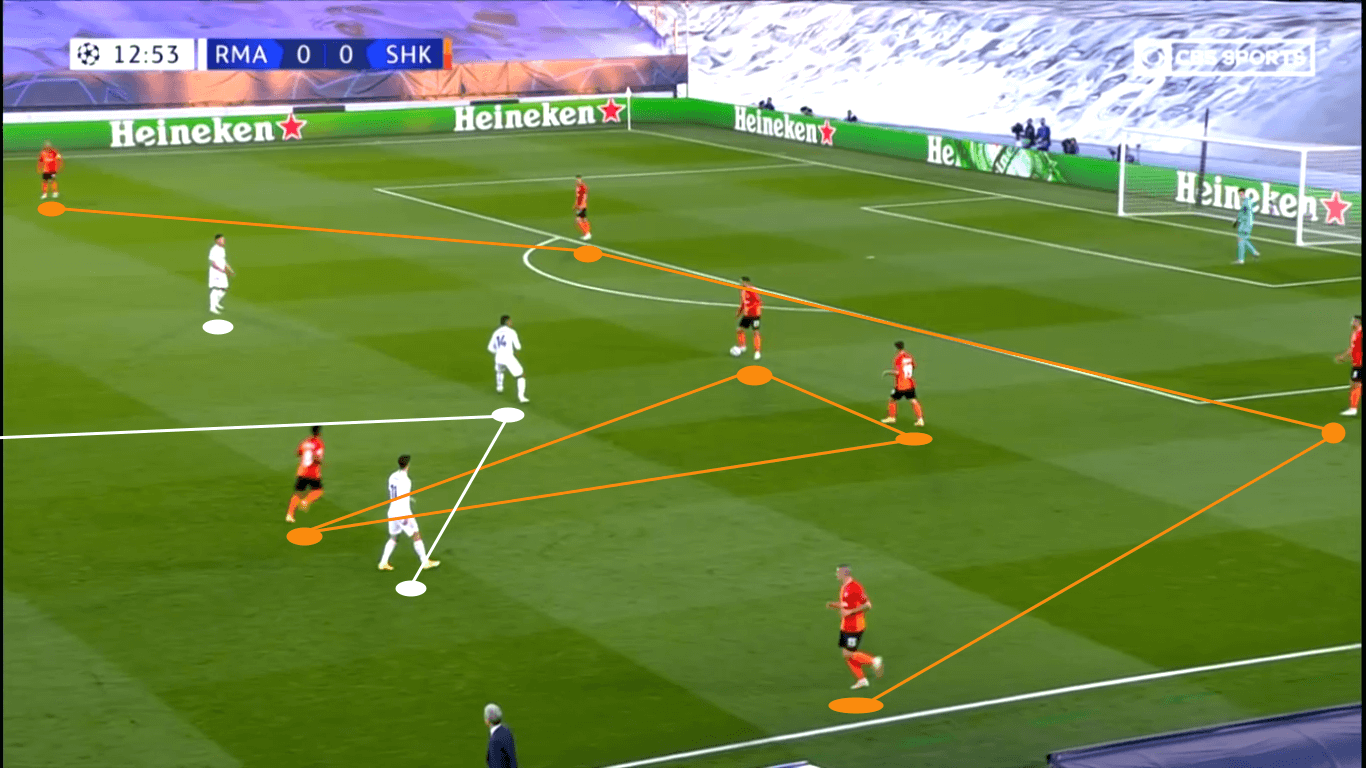
Six seconds later, a fourth Madridista arrives. While five or six engaged in the press would be preferable, one of those players is Casemiro, and there’s nothing but space behind him. Shakhtar played out to the right, allowing Marlos to initiate the first wave of progression.
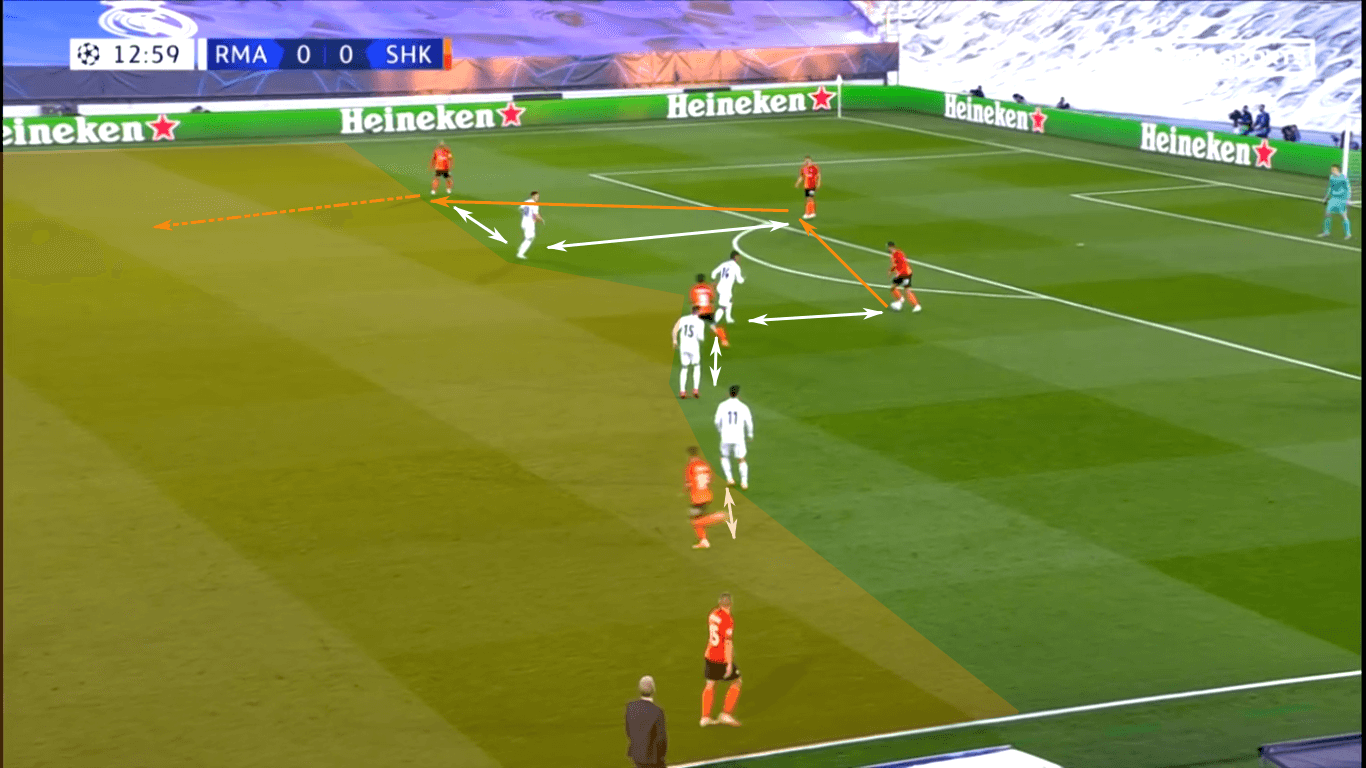
Though Marlos was able to progress through the dribble, Real Madrid’s backline was initially very disciplined. Since the centre-backs hadn’t pushed into the midfield, the Hirnyky continued to patiently move the ball while casting glances downfield.
Finally, it happened. Dentinho and Marcos Antônio moved between the lines. Varane and Militão both stepped, opening up the run for Marlos. Maycon did well to pick out the run, sending a perfectly weighted ball over the top. Though Courtois saved the breakaway opportunity, this sequence was a foreshadowing of events to come.
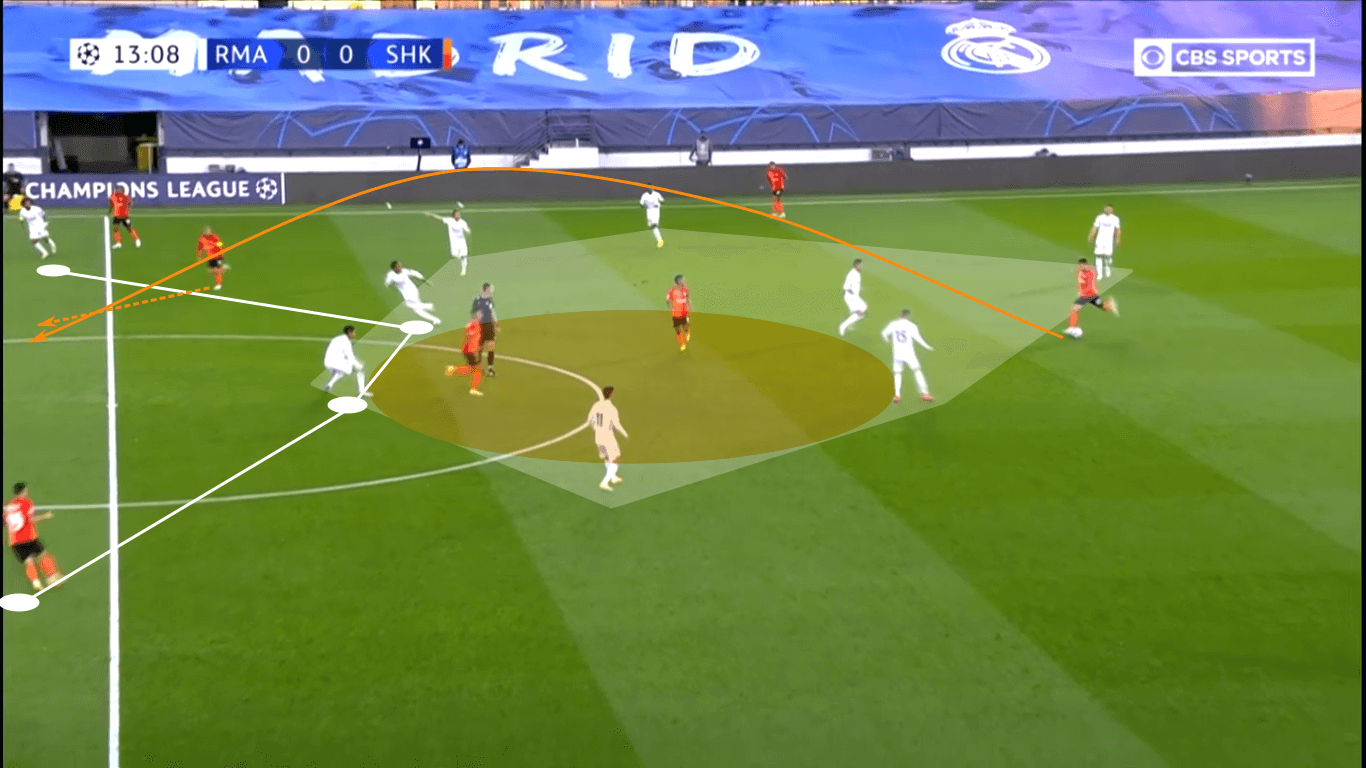
Looking at it from another angle, when Varane and Militão both stepped, Marcelo and Mendy failed to move forward with them or move centrally in coverage. The total disconnect created a central pocket to emerge, allowing Shakhtar to attack in the most dangerous channel with north-south movement. They were so quick to pick out the mistakes of the centre-backs that Varane and Militão never had a chance to recover.
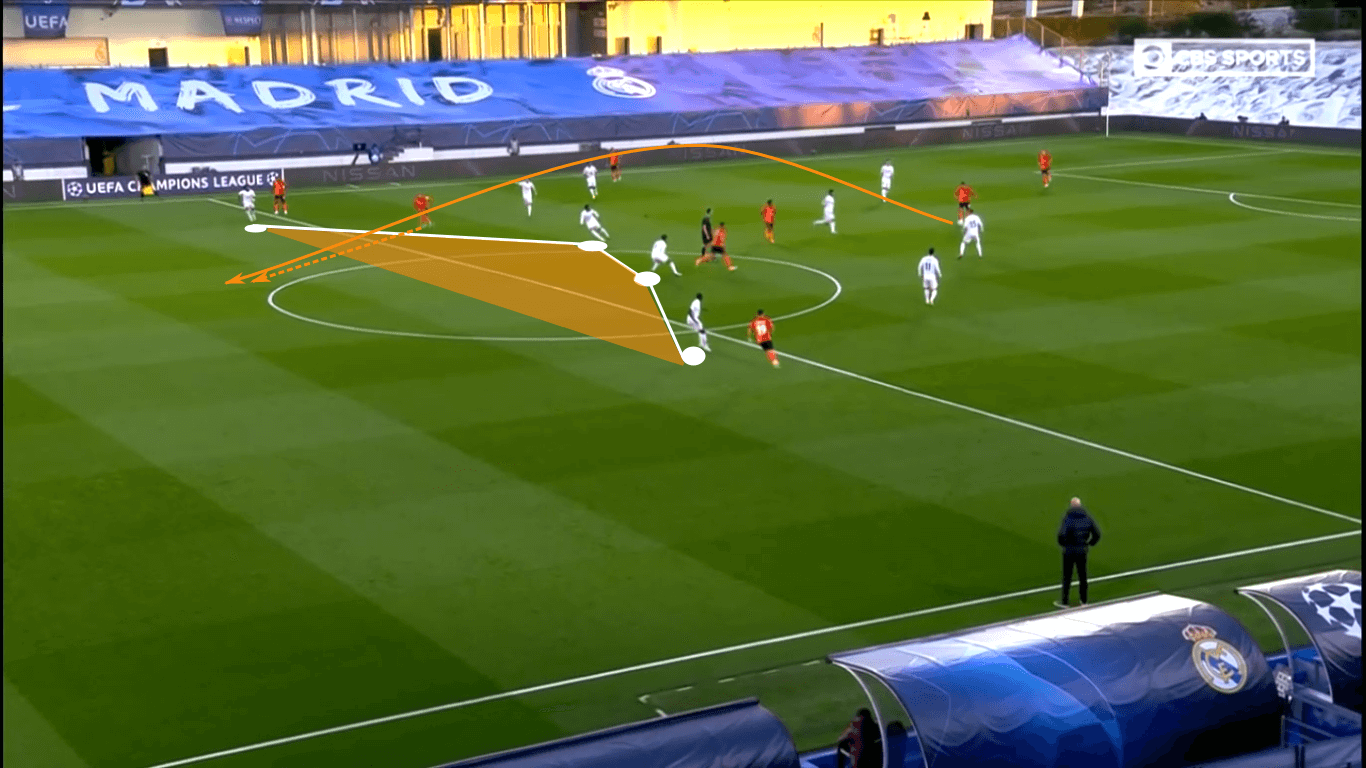
From Madrid’s perspective, the lack of chemistry between Varane and Militão is certainly troubling, especially if Ramos misses El Clásico. When Varane and Ramos are on the pitch together, it’s the Spaniard who aggressively pushes into midfield while the Frenchman covers depth. In this match, the lack of understanding between Varane and Militão showed. Castro’s boys were quick and ruthless in attack, punishing that disconnect throughout the first half.
Second half adjustments
This is where the game really got interesting. While the first half saw several well-constructed Shakhtar attacks and the shock value of the 3-0 lead, Real Madrid finally showed a sense of urgency in the second half as the Zidane pulled all the stops. Rodrygo, who was more or less a passenger in this one, was the first player to grab a seat. Karim Benzema replaced him, giving Real Madrid a hard-working and creative presence higher up the pitch. Jović followed soon after, making way for Vinícius Júnior. The Serbian’s dreadful tenure at the club saw him put in another underwhelming performance, recording just three touches in the box and sending nine passes in 59 minutes.
Below is a passing map that incorporates each player’s average starting/first touch position. Shakhtar played rather deep most of the match, but the map is heavily influenced by the fact that they rarely left their defensive half in the final 45 minutes. For Real Madrid, the two deepest field players are settled at midfield.
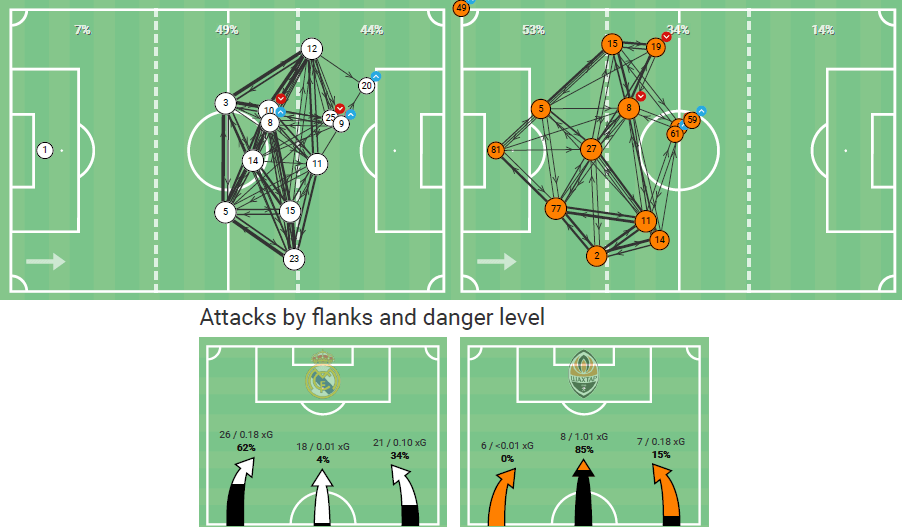
Additionally, the attack map and danger level give an indication of each team’s attacking preferences. Shakhtar was rather balanced overall, but their greatest success came through the middle of the pitch. For Real Madrid, the left was used more often than the other two areas, but you can see the general lack of success they experienced in this game.
A significant reason for their issues in creating high-level scoring opportunities was Castro’s halftime adjustment. In the second half, Shakhtar got everyone behind the ball. The centre of the park was as packed as a highway during rush hour. There was very little space to penetrate. Modrić’s goal represented one of the few occasions for central penetration. With the Shakhtar defence still in their corner kick defence shape, Modrić received the pass from Marcelo, then drove around his defender, finishing with a spectacular across the body shot.
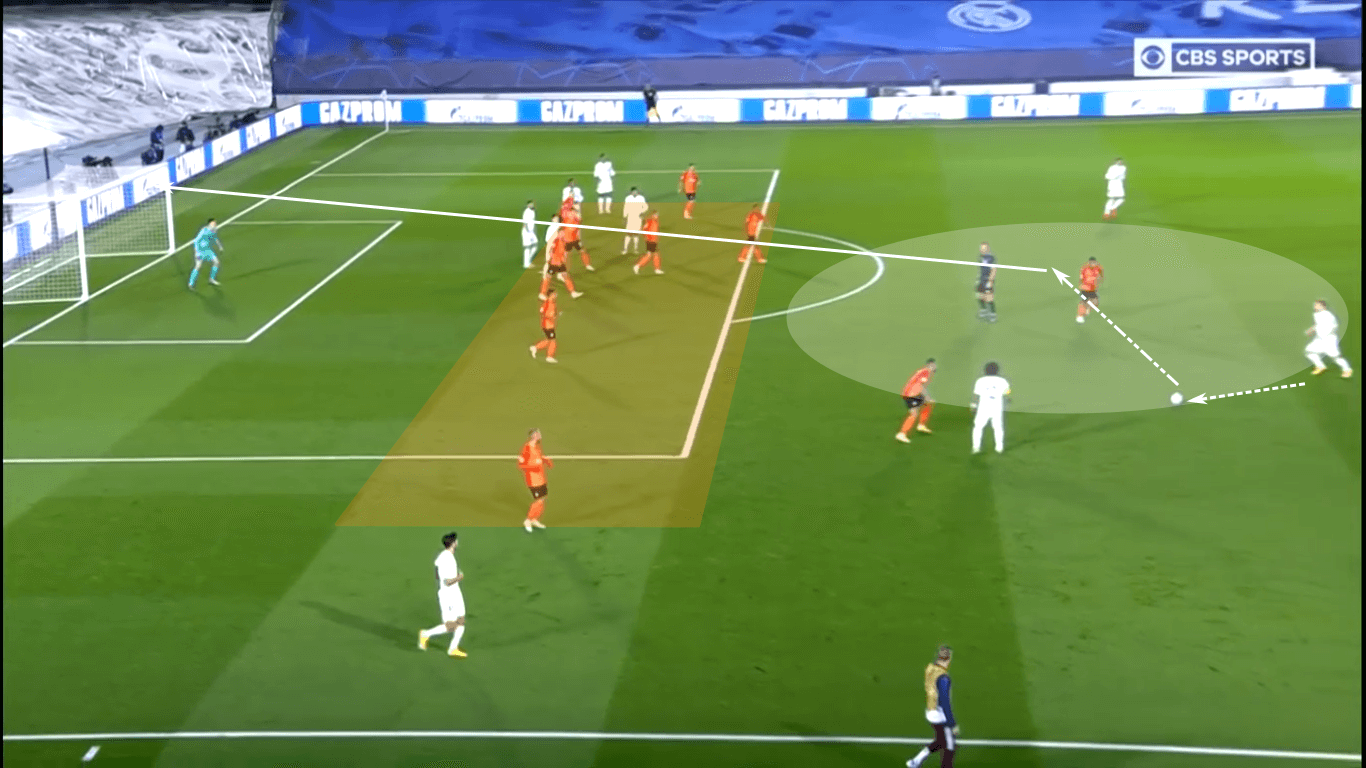
Real Madrid’s biggest adjustment in the second half was the counterpress. Their PPDA shot from a lowly 19.5 in the first half to an elite 6.8 in the second. The task was certainly helped by Shakhtar’s lack of outlets high up the pitch or in the wings, but that doesn’t take away from the noticeable change of tempo in the match.
The man-marking high press was much improved too. Rather than six Real Madrid players getting caught up high, disconnected from the backline, only as many players as were necessary pushed up the pitch. That allowed the backline to maintain their shape and keep the centre-backs from pushing into midfield.
In the image below, which is the scene right before Vini Jr.’s goal, his first touches of the game. Real Madrid is plus one at the back, Vinícius Júnior was initially wider to take away the wing outlet, but he noticed Marlos’ body orientation would allow him to pressure the ball unnoticed.
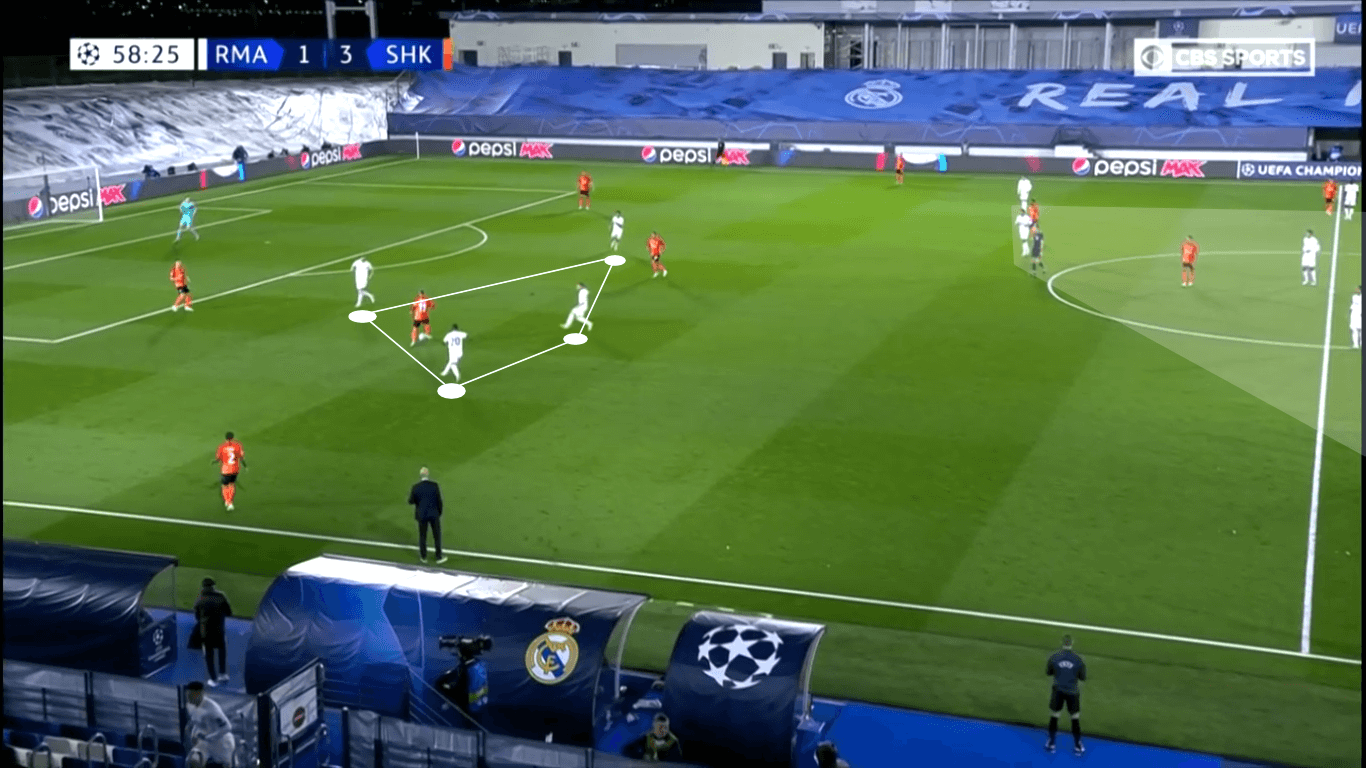
The goal dropped the deficit to a goal with just over 30 minutes to play. Neither coach made any changes until the 70th minute. That’s when Zidane brought in Kroos. With Shakhtar play incredibly deep, getting everyone behind the ball, Zizou needed someone who could spray the ball across the width of the pitch. That, of course, led to the German’s introduction.
As the game progressed into the later stages, that Shakhtar press became a 6-3-1 in the low block. Countering that structure, Kroos took his preferred place in the left half space, as seen below. From there, he was able to play directly into either wing.
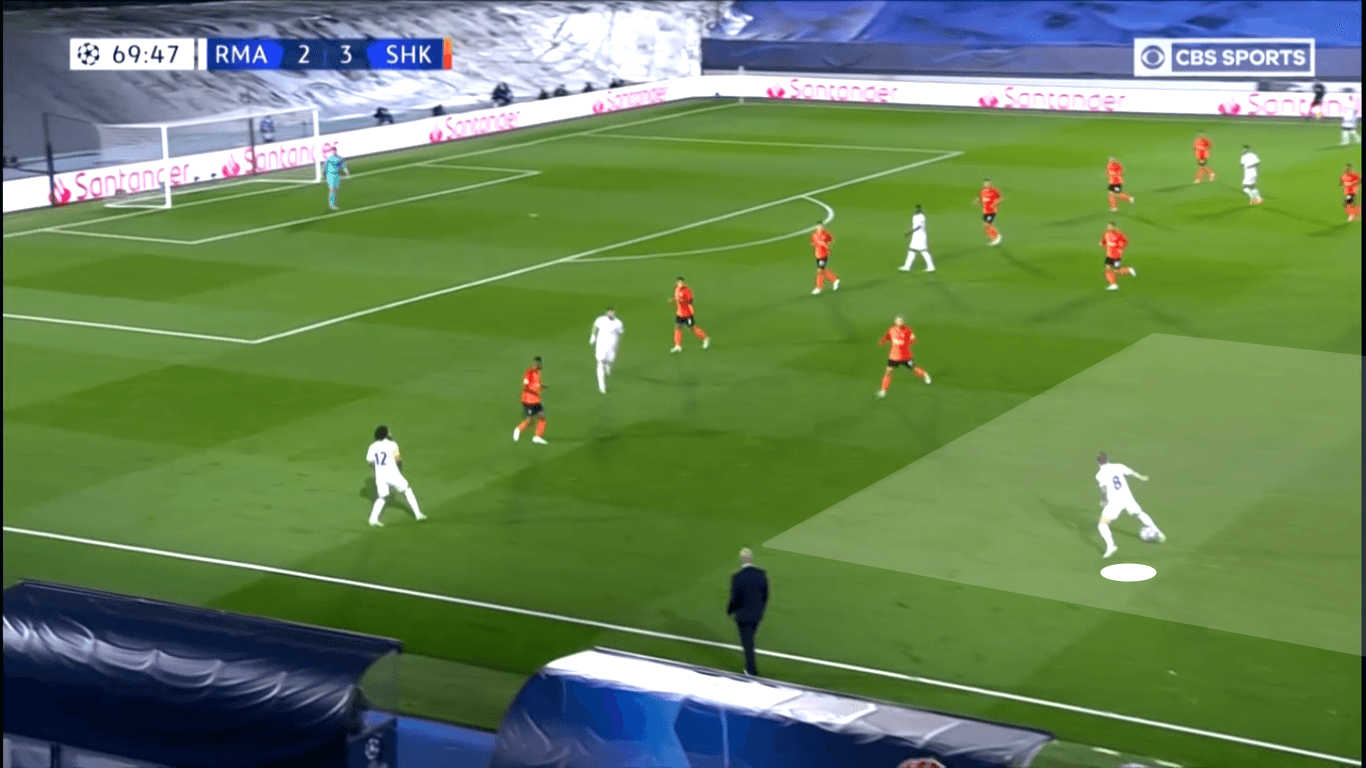
For the majority of the second half, Los Merengues overloaded the middle of the pitch, leaving one player on either wing to provide width. Since Shakhtar was also overloaded in the middle, Real Madrid’s emphasis in central numbers wasn’t to create opportunities through the middle. Rather, it was to set up crosses or play runners into the half spaces, allowing them to make the final pass closer to goal.
In the sequence below, we see that central overload. Marcelo, Modrić and Casemiro make up the bottom of the quadrilateral while Benzema, Jović and Valverde form the top portion of the line. Mendy moved into a wider space to offer the pass down the line, but, in this case, its Asensio and Vinícius Júnior providing width.
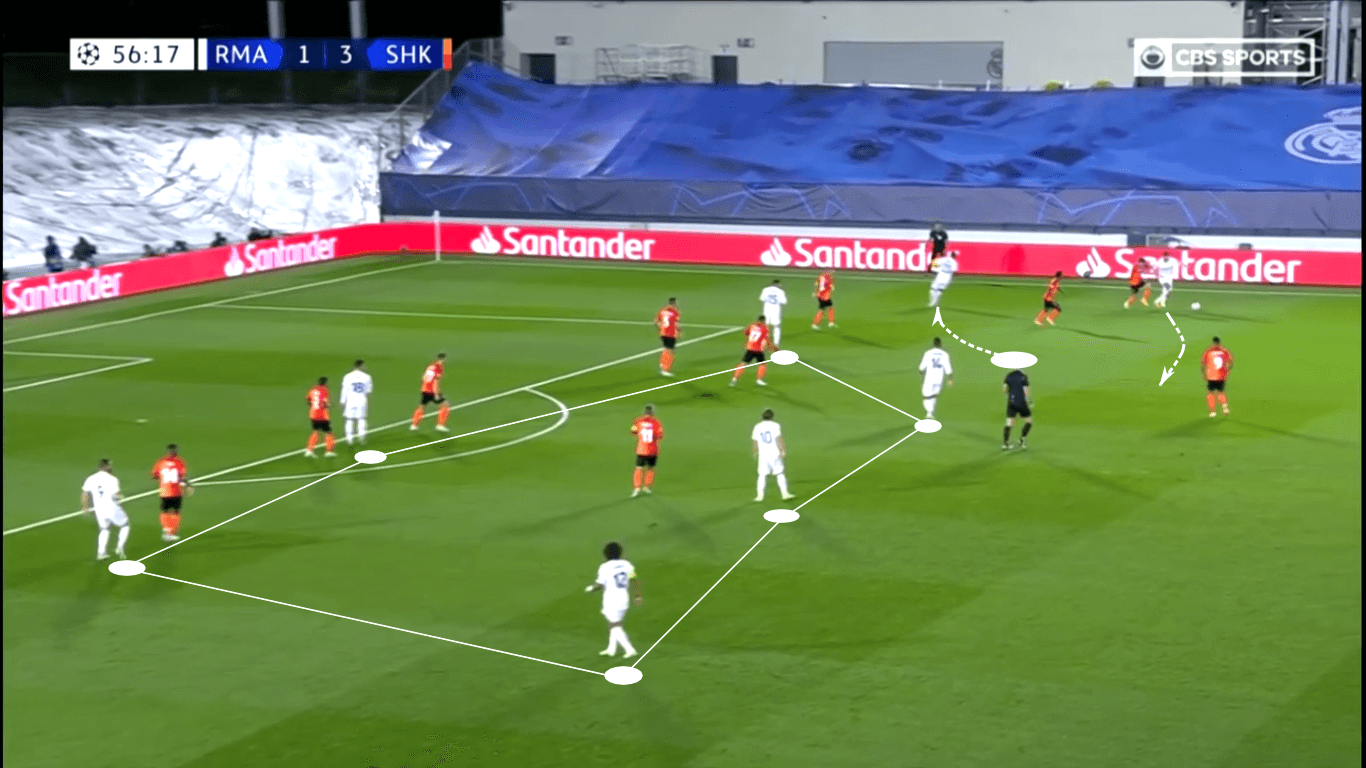
After a quick recycle, Mendy, who’s moved into that width-provider role, plays a ball down the line to Valverde. The young Uruguayan managed to track down the ball, but the delivery was right the keeper, Trubin.
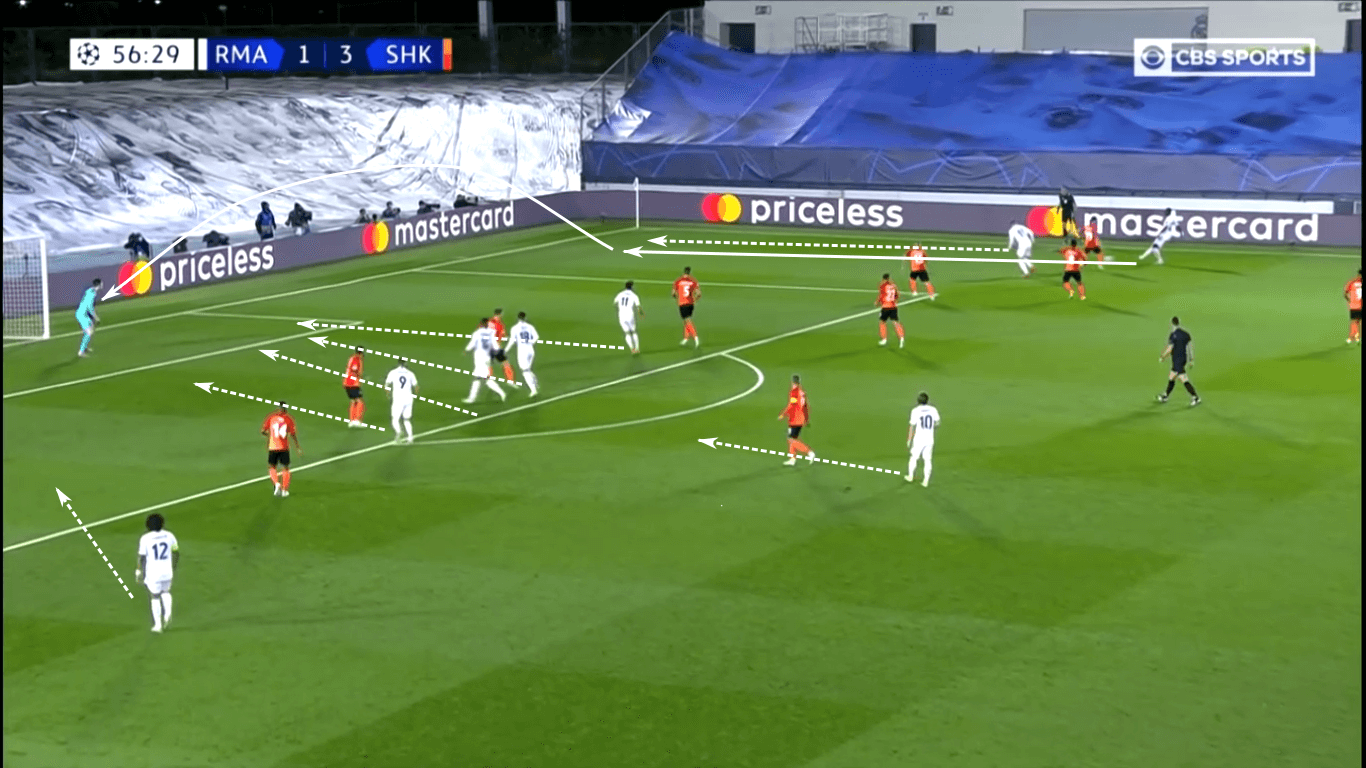
Despite the poor delivery, one that missed a 4v2 opportunity in the goalmouth, the four runners into the middle of the box, plus Marcelo at the back post, show that Madrid had mostly resigned themselves to crossing. For the game, they sent a total of 41 crosses, connecting on 12 (29%). Given the high frequency, easily the highest total of any match I’ve analysed for Total Football Analysis, the 29% success rate is a reasonably good one. Still, Shakhtar managed to win 59% of the match’s aerial duels and cleared the ball a remarkable 31 times. Their 62 interceptions far outweighed the 25 from Los Blancos.
Overall, the final 30 minutes played out exactly as Shakhtar would have hoped. With so little space in the middle, Real Madrid was forced wide, making play predictable and easy to cover.
Conclusion
Real Madrid’s low xG total gives an indication of how well the Ukrainian side handled the pressure. A horrendous first half put them in a massive hole, allowing Shakhtar to park the bus in the second half. With so many numbers behind the ball, they were easily able to see out the final 30 minutes of the match. Following the La Liga loss to newly-promoted Cádiz and ahead of this weekend’s Clásico, Zidane knows his side is in a funk, vowing to find the solution before the match against their archnemesis, Barcelona.
For Shakhtar, this is a dream result, especially given the circumstances. Those three points are a massive help in their bid for knockout round qualification. Provided their key players are ready for the Inter Milan game, they have the opportunity to head home and secure a six points out of six start to the UEFA Champions League. They’ll face 2nd place Vorskla in Ukrainian Premier League action this Saturday, but they’ll be incredibly pleased to have started a difficult week with three points in Madrid.





Comments